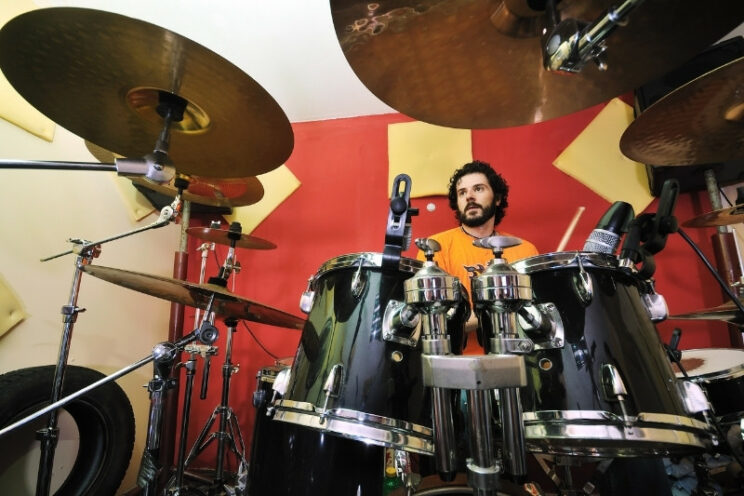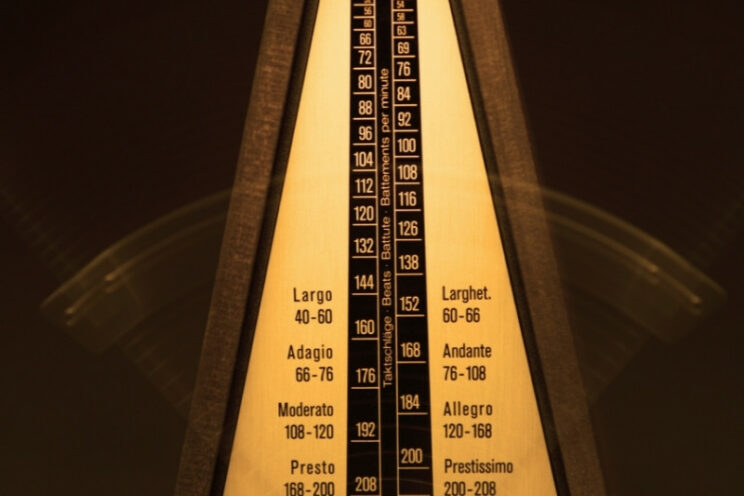Rhythm Exercises – 8 Tips to Improve Your Rhythm

Music is all about rhythm. Keeping time is one of the most essential abilities you’ll need, regardless of instrument or style. Rhythm is a must-have for anyone, regardless of skill level.
The most significant aspect of music is rhythm, and having a feel for it separates the skilled from those that aren’t.
Even when you play some very melodic tune, a few wrong notes won’t be the end of the world. However, playing off time can be very noticeable.
When someone has a great sense of rhythm, people usually talk about talent. Therefore, many musicians, even professionals, neglect it and don’t work hard enough.
This is where most mistakes are made, no matter how talented you are, nothing beats hard work and practice.
Just like every other thing in life, rhythmics are mostly about practice. Everyone should be able to hit his mark, but the goal is to commit oneself to practice and prepare for a hard effort.
Here are some tips that will make you practice routine more efficient:
Contents
1. Purposefully Practice Your Rhythm

This would be the first and probably most important step. There are many musicians who practice for hours.
However, most of them don’t focus on rhythm and timing in particular. Instead of that, they usually work on things like beats, scales, patterns, licks, and similar things.
You can only really improve your rhythm when you commit to focusing on it. As mentioned before, practice beats everything. If you put your head down and practice enough, then this will be second nature to you and can only impact your playing positively.
2. Start With the Basic Counting
Even if you play some instrument for years, don’t be ashamed to start from the most basic things. For example, start with listening to your favorite songs and start to tap and count the beats. Start with taping your leg, hand, instrument, etc.
Then start counting. Soon after, you will be able to realize the time signature of a particular song. There are four beats to the vast majority of mainstream music (the 4/4 time signature), while three beats are usual for a waltz.
Once you become good with the most basic time signatures, you can also move on to some more complex pieces of jazz fusion, oriental music, and other genres.
3. Subdividing
You shouldn’t skip this step. When someone is considered to have a great sense of rhythm, he is actually able to subdivide beats of the song into shorter beats and then make various kinds of combinations.
For example, the most basic beats consist of quarter notes only. So, the basic count would go “one, two, three, four”. Insert the “and” between each number (“one, and two, and three…”) and you get the eights.
For a more complex subdividing, a good tip is to combine taps and counting. Start to tap slowly and the count between each tap. This way, you can make every kind of subdividing, of course, if you practice enough.
4. Use the Metronome

No matter which instrument you play, play it with a metronome. There is no better exercise for keeping tempo than using this tool. There are numerous apps that you can use on your phone and you can find them here.
No matter if you’re exercising licks, scale patterns, or entire songs, the great thing about metronome is that you can start exercise at a slow pace and then go to the desired speed gradually.
Besides metronome, modern technology offers various other kinds of practicing tools. Virtual metronomes and rhythm apps are just some of them. You can also use software like Drum Beats+. This app is packed with all kinds of grooves, which make it a perfect practicing machine, as well as a great jamming and songwriting tool.
5. Record Yourself
Hearing your playing on the track can be great feedback. It is a great method for improving rhythmics, even if you have years of playing behind you.
Find a simple tune or something that you’ve been practicing for a while. Record it without backing track or metronome. Once you play the track, you should be able to hear if there are some mistakes like dropping off the beat, hesitating, etc.
Another important thing about this tip is to be mentally prepared. In simple words, don’t get frustrated if your rhythm is not as strong as you thought. You should actually view this as a positive because you have identified areas for improvement.
6. Rhythmic “Double Dutch” is Mother of all Exercises
If you are an intermediate player, here is the perfect practice for you. No matter if you are playing drums or any melodic instrument, a so-called rhythmical double dutch will significantly improve your rhythmic and playing in general.
Not only that the exercise is amazingly effective, but also offers plenty of fun.
The first thing that I would recommend is random jump-ins. Find the track you know and play it on an MP3 player or any other device. As soon as the song begins, you can start with jump-ins at any time, any part of the song.
There is no better and more fun way to master your timing.
Once you master these “jump-ins”, go for something harder, a more complex “double dutch”. For example, take some lick you’ve learned, a riff, or any other pattern. Start with muting or chopping off some notes of the pattern, either beginning, end, or something in the middle.
Play in such a way that some of the notes are removed, but keep original beats and timing in mind. Keep in mind all fourths, eights, or sixteenths you’ve decided to remove. This approach allows all kinds of experiments, which would eventually improve not just your rhythm, but improvisation skills in general.
7. Commit to Tackling Trouble Spots
Compared to previous, practical tips, this one is rather a matter of attitude. Just like in every other aspect of life, there is no excuse for giving up when things become hard.
Sometimes, you will face some pretty tricky rhythmical things to learn – fast patterns, tricky beat dividing, odd time signatures, etc. Sometimes, it takes days or weeks, even months to master them. The point is to be persistent, because for a very simple reason.
The bigger problem you deal with, the better musician you’ll become after solving it.
8. Practice with Other Musicians

Compared to the previous tip, this one is very practical. Getting routine is crucial if you want to be something more than a bedroom player. Find a band to play with.
Even if you’re playing something that isn’t your cup of tea, all the backing tracks and other generic tools can’t replace playing with other musicians. Improving rhythmics and timing in a permanent process. There are never enough rehearsals and live performances.
If you can’t find a decent band around, find a neighbor or friend who is a better musician than you. No matter how different the two instruments you play are, you can always learn a lot of things from someone who has a great sense of rhythm.
Conclusion
A maintainable and sustainable rhythm is crucial in every music genre where the beat matters – be it jazz, funk, metal, or electronic music. No matter what your level of expertise is, you must practice with great attention towards rhythmic accuracy and intensity.
Rhythm is the main pillar of music. And it matters a lot in all kinds of genres and playing styles. Also, no matter how difficult things might be, always remember that anything is possible if you’re trying hard enough.
There are many more tips for improving rhythmics and timing. However, I think these are among the most important ones. Even if you’ve been playing for years, you should find the advice in this article useful.
Practice as much as you can and results will come!







